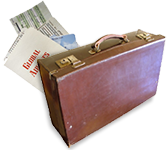Last week, I had to get from downtown Washington DC to a Northern Virginia suburb for a client dinner. I looked at the Metro map, rang up some car services, but finally gritted my teeth and rented a car. That’s pretty much my attitude toward car rentals these days — the choice of last resort. It wasn’t always this way. But with cost and fee increases, shrinking fleets, and more inconvenient locations, I work hard to skip the rental car counter.
The biggest issue is cost. Rental car prices have soared — increasing an average of 60-70% over last year. But prices are just part of the story. Additional fees and taxes can add another 50% to the number that finally hits your credit card. The concession recovery fee that airports and train stations charge is usually one of the bigger charges. Avis hit me with 11.11% concession recovery fees on recent trips through Seattle-Tacoma and LAX airports, and a 10% fee for renting at Philadelphia’s 30th Street train station. Picking up the car in town doesn’t always dodge this fee. Hertz leveled a 13% concession recovery fee on a rental from the San Francisco Marriott hotel. On top of that, the rental companies add on a customer facility charge, a vehicle licensing fee, and an energy recovery fee. And then the state and local governments’ turn. My Sea-Tac rental receipt shows a 9.5% sales tax plus a 9.7% rental tax. California adds 3.5% tourism assessment fee. My Philadelphia rental had 4% passenger car rental tax (split between the state and the city) plus a $2/day state surcharge. Just across these four examples, fees and taxes added 27-51% to the final cost of my rental.
Another problem is being able to get a car. The easiest way for rental car companies to make more money is to increase each car’s utilization — the number of days it’s rented. Makes sense, but when demand for cars increases just a bit, the pickings start to get slim. Last month, I flew from LAX to Washington-Dulles and planned to rent a car because it would be a bit cheaper than the round-trip cost of a cab to/from DC. I landed at Dulles around midnight. Wheeling my bag across the empty Avis Preferred parking spaces, I saw a huge Ford F150 4×4 King Cab pick-up truck. “They can’t be serious,” I thought. Oh yes, they were — that was their idea of the intermediate size car I had requested. This wasn’t going to fit in a parking garage in downtown DC. I walked back to the rental bus and asked the driver to take me to the taxi line.
Of course, the drive back to the airport taxi line wasn’t a short one because airport authorities have been aggressively relocating rental car companies to “improved” consolidated facilities that are a 15-20 minute drive from the airport. Frequent travelers work hard to reduce the time spent getting from one point to another — maintaining airline status so they can use the short security line, carrying on their bags so they don’t have to wait by the luggage carousel. Renting a car used to be a quick transaction — walk off the plane, across to the parking lot, and into your rental car. It’s still that way at smaller airports like Nashville and Little Rock, but at airports like Cleveland, Baltimore-Washington, and Phoenix, you need to pack a lunch.
I used to enjoy renting cars. Now, I avoid it. Hikes in prices and fees have made taxis and private car services more competitive, and moves to push rental lots way off property have made the alternatives a lot more convenient. Last year, at the tipping point where the cost of rental car was the same or maybe even a bit more than the cost of a taxi, I’d take the rental car. I enjoyed the flexibility of having a car, and even looked forward to finding a fun car in the Avis lot or under the Hertz Gold canopy. Now, I’ll pay extra to avoid them. While I work every year to make sure I keep my Marriott Platinum status, I fell out of Hertz’s President’s Circle without a care.
